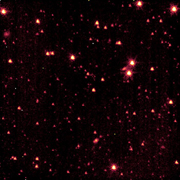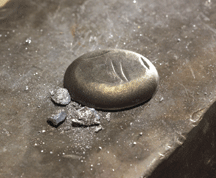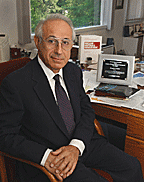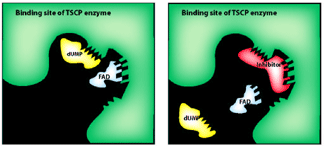Research
Highlights...
|
|
|
Brookhaven's
Joseph P. Indusi
|
|
 |
| Number 143 |
October 13, 2003 |
|
Novel manufacturing process developed for thin-film solar cells
A researcher at DOE's National Renewable
Energy Laboratory has developed a novel process for producing
lower cost thin-film cadmium telluride (CdTe) solar cells with
a confirmed 14 percent efficiency. In conventional thin-film manufacture,
semiconductor materials are layered between glass and a back contact
and heated several times to high temperatures. The new process
has only one heat-up period and includes two techniques developed
at NREL that have the potential to increase performance. Further,
the reduced temperature in the NREL process allows the use of
inexpensive soda-lime glass, which has a low softening point.
[Sarah Barba, 303/275-3023;
sarah_barba@nrel.gov]
|
|
Training class instructs
U.S. border inspectors on weapons detection
 |
| Customs
agents use radiation detectors to check a small sample of
uranium during a mock exercise in which the agents interviewed
a suspicious man trying to cross the border and searched his
vehicle. The uranium ingot was found hidden in an emergency
light. |
Scientists at DOE's Pacific Northwest
National Laboratory are training
U.S. Customs and Border Protection inspectors to identify and
halt smuggling of weapons of mass destruction during three-day
training courses in Richland, Wash. About 25 inspectors participate
in each course and nearly 400 CBP officers have completed the
training program, which just began its second year. U.S. border
inspectors receive comprehensive training to detect, identify,
interdict and investigate the illicit movement of materials, commodities
and components associated with the development or deployment of
weapons of mass destruction. The course curriculum includes classroom
instruction, as well as hands-on demonstrations and exercises
designed to familiarize inspectors with the materials and components
associated with weapons of mass destruction and dual-use items.
PNNL and the CBP share instructional responsibilities, while the
National Nuclear Security Administration funds the training.
[Staci
Maloof, 509/372-6313;
staci.maloof@pnl.gov]
|
|
TeraGrid to link with
Oak Ridge neutron science facilities
 |
|
SETENS:
A Southeast TeraGrid extension for neutron sciences (click
image for larger view)
|
Researchers from around the nation will have access to data from DOE's
Oak Ridge National Laboratory
neutron science facilities because of a $3.9 million grant from
the National Science Foundation. The grant to ORNL's Center for
Computational Sciences will fund a network hub and high-performance
network connections to the TeraGrid, which when complete will operate
at 40 gigabits per second and be the fastest research network in
the world. The TeraGrid will provide scientists extraordinary amounts
of data from ORNL's High
Flux Isotope Reactor and the Spallation
Neutron Source. Grant collaborators were the University of Tennessee,
Georgia Institute of Technology, Duke University, Florida State
University, North Carolina State University, Virginia Polytechnic
Institute and University of Virginia.
[Ron
Walli, 865/576-0226;
wallira@ornl.gov]
|
|
Berkeley Lab far infrared
detectors in orbit
 |
| NASA's
Space Infrared Telescope Facility (SIRTF) |
DOE's Berkeley Lab researchers Eugene
Haller and Jeffrey Beeman developed and helped fabricate two of
the far infrared radiation detector arrays aboard NASA's Space
Infrared Telescope Facility (SIRTF), which is now in orbit around
Earth. SIRTF is designed to capture images of previously hidden
celestial objects and phenomenon. The germanium crystals doped
with gallium that Haller and Beeman developed are far and away
the most sensitive detectors of far infrared radiation ever to
be sent into space. They will be especially useful for studying
the history of early star formation and the evolution of galaxies
and planetary systems.
[Lynn
Yarris, 510/486-5375;
lcyarris@lbl.gov]
|
|
Ductile intermetallics
discovered
 |
| A
button of yttrium-silver dented by repeated hammer blows |
Intermetallic compounds have long been known to possess chemical,
physical, electrical, magnetic and mechanical properties that
are often superior to ordinary metals. But their potential has
gone untapped because they are typically quite brittle at room
temperature. Now researchers at DOE's Ames
Laboratory have identified 12 fully ordered, completely stoichiometric
intermetallic compounds that are ductile at room temperature.
The discovery, announced in an article in the September issue
of Nature Materials, could make these promising materials
more useful. The study, led by senior metallurgist Karl Gschneidner,
Jr. and associate scientist Alan Russell, has focused on yttrium-silver,
yttrium-copper, and dysprosium-copper, but a preliminary examination
of other rare earth compounds showed that they are also ductile.
[Kerry
Gibson, 515/294-1405;
kgibson@ameslab.gov]
|
|
Female physicists lead
the way on Jefferson Lab experiment
A recent physics experiment at the DOE's Jefferson
Lab set a new Jefferson Lab record: the most female scientists
on an experiment. The experiment, which ended in July, boasts
two spokeswomen. A female postdoctoral fellow is overseeing data
analysis. The research is central to a female graduate student's
doctoral thesis. And the majority of scientists working shifts
during the experiment were women, many of them undergraduate physics
students. Cynthia Keppel, a Hampton University professor and experiment
co-spokesperson, attributes the female majority to what she calls
"the best reasons, a change of gender climate and good science."
Keppel believes that once the field starts having enough women
around, physics experiments run by women will eventually become
commonplace.
[Debbie
Magaldi, 757/269-5102;
magaldi@jlab.org]
|
|
Brookhaven's
Indusi champions homeland security and classic Buicks
 |
|
Joseph
P. Indusi
|
Joseph P. Indusi, chair of the Nonproliferation
and National Security Department at DOE's Brookhaven
National Laboratory, is vigilant about assessing risks to
national security in the post 9/11/01 era. But it was the first
terrorist attack on the World Trade Center a decade ago that
shifted the focus of his department.
"Since 1993, we have been focusing more of our efforts on anti-terrorism
initiatives," Indusi said. "Recently, we have been working with
the Department of Homeland Security to test and evaluate radiation
detectors for use in the New York metropolitan area. We also
are developing advanced radiation detectors that can be used
to trace radiation from devices such as dirty bombs. The department
has also been part of a team conducting vulnerability and risk
assessments at critical infrastructure facilities in New York
State."
Indusi's department provides technical assistance to promote
enhanced safeguards and security systems for the protection
and accountability of weapons-grade nuclear materials, in cooperation
with Russian nuclear facilities. It also develops safeguards
systems and arms control verification technology to stem the
spread of nuclear, chemical and biological weapons. To support
nonproliferation of these weapons, the department provides non-weapons
related jobs to Russian weapons scientists in their homeland.
Further, the department provides technical oversight of projects
designed to strengthen the International Atomic Energy Agency's
safeguards, and it addresses the environmental and proliferation
concerns associated with dismantling Russian nuclear submarines.
"I've been entrusted with a job at Brookhaven that is extremely
important for the safety of the nation and the world," Indusi
said. "I take that role very seriously, and I believe that my
staff of about 40 experts and I perform it very well."
 |
To unwind from work on national security issues in his leisure
time, Indusi enjoys rebuilding classic Buicks. He owns a 1948
Buick Special Two-Door Sedanet, which he restored to showroom
condition. He is currently restoring a recently acquired 1953
Buick Special 2-door hardtop. Also, he has had several articles
published in The Bugle, Buick Club of America's newsletter.
Submitted by DOE's Brookhaven
National Laboratory
|
|








